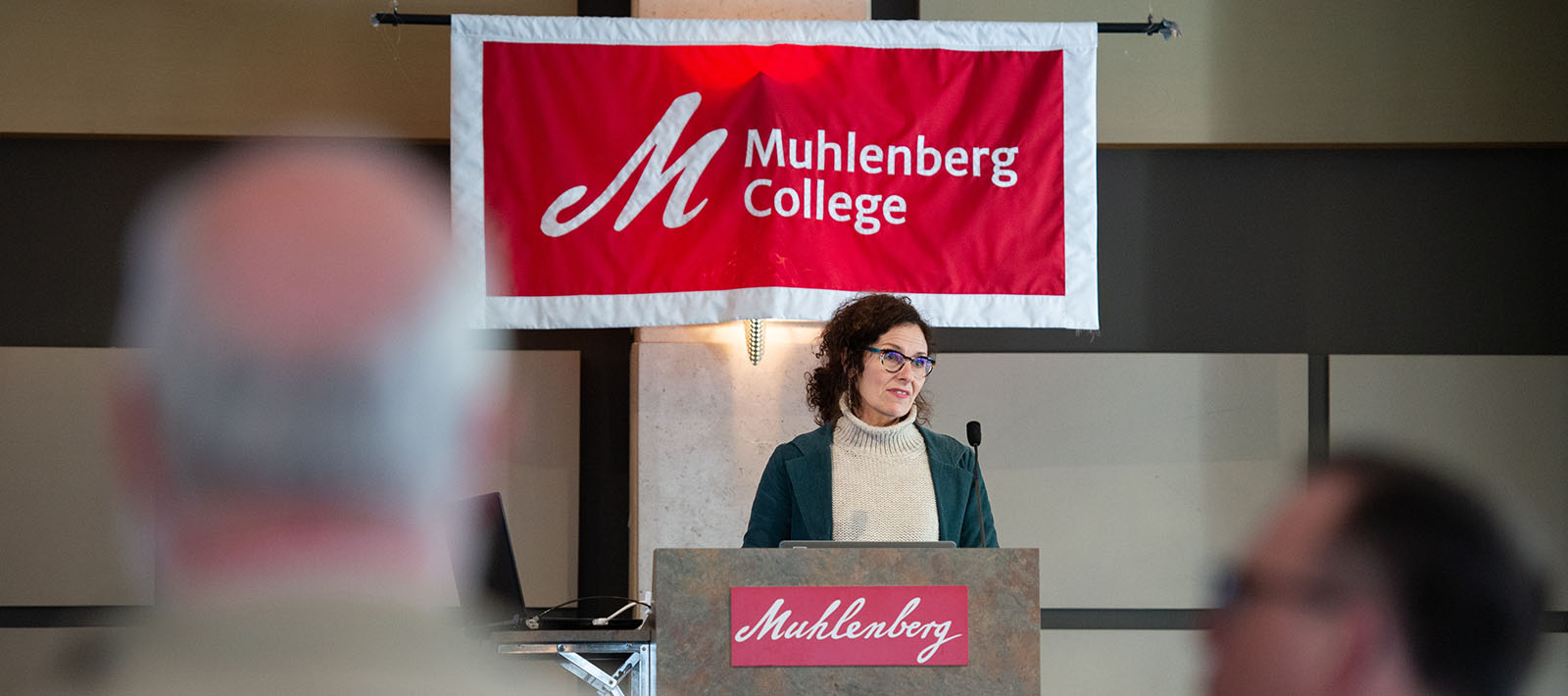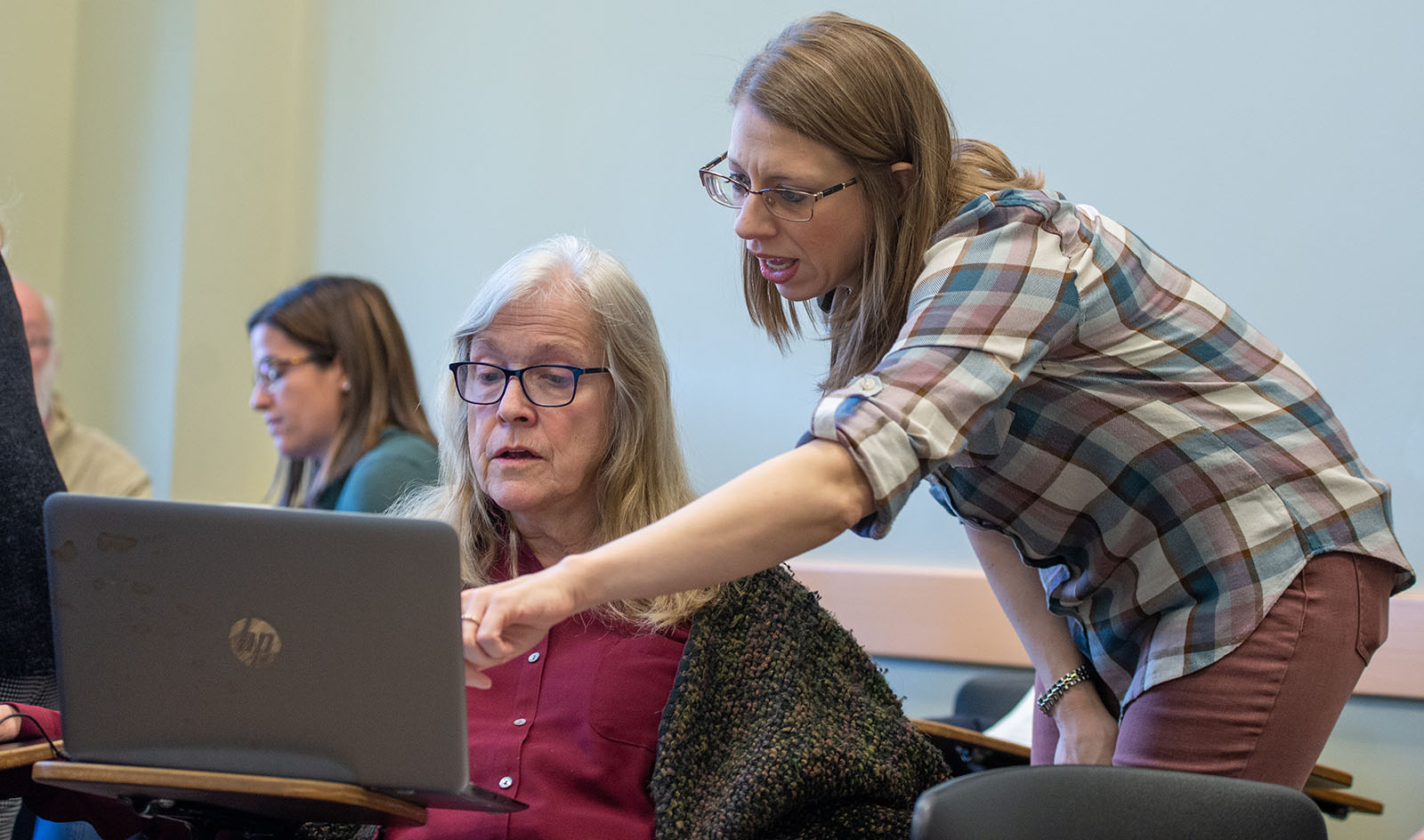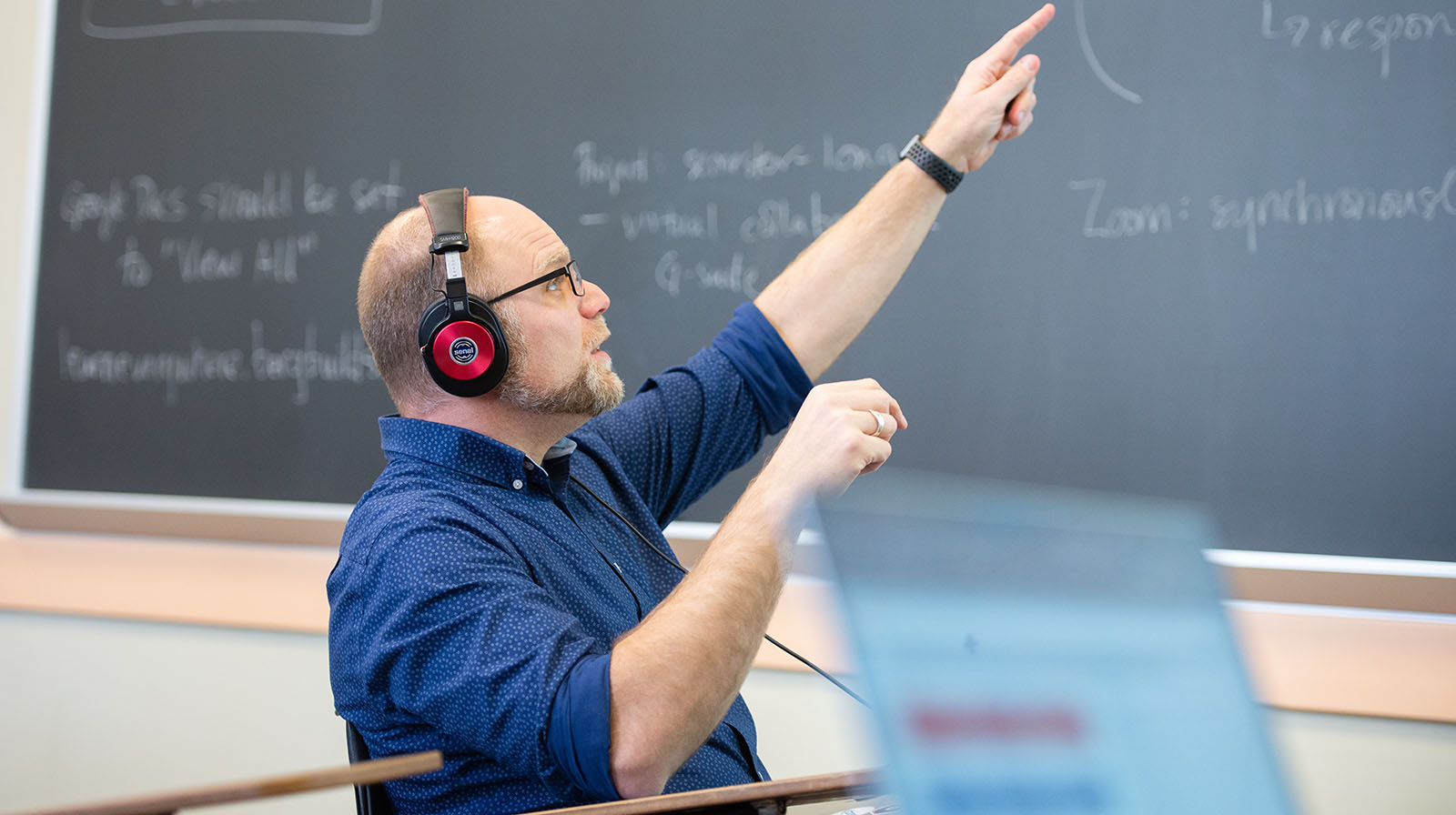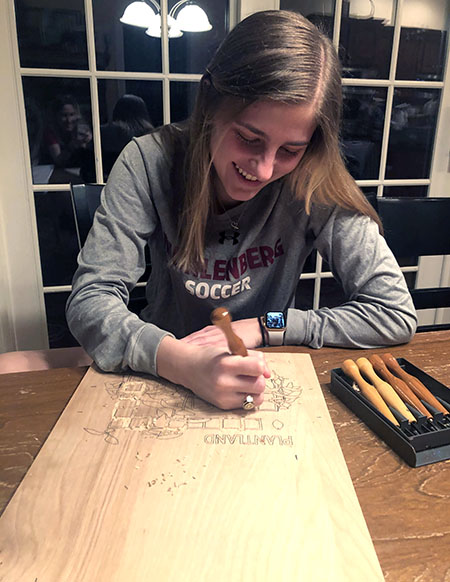Urgent Online Learning
Over a long weekend, Muhlenberg’s faculty prepared to continue courses remotely in response to the COVID-19 pandemic.
By Meghan Kita | Photos by Bill Keller
It’s Monday, March 16, just a few days after most students left campus in the wake of the COVID-19 pandemic, and faculty and staff are scattered throughout Moyer Hall’s Miller Forum. About a dozen people sit in the four rows of chairs in front, with at least two empty chairs between each person. Some attendees spread out at round tables farther back. A few people lean against the walls to better practice “social distancing,” a novel concept to many...for now.
The day’s purpose is training to continue courses through what’s planned to be a four-week campus closure. (This time next week, the College will announce that it will remain closed for the entire spring semester in response to a surge of COVID-19 cases locally and nationally.) Some faculty are here to learn how to begin teaching remotely; others, to help teach their peers—42 faculty members have completed the five-month training required to construct and teach a fully online course. The digital learning team and the Office of Information Technology (OIT) collaborated to create today’s agenda, which begins with remarks from Interim Provost Bruce Anderson and Dean for Digital Learning Lora Taub (pictured below).
Taub begins by inviting everyone in the room to take a deep breath. Then, she shares some of the ways she’s coping with uncertainty and change (yoga, Twitter, chocolate, poetry) as well as an excerpt from a Wendell Berry poem called “Stay Home.” The day’s purpose, she says, is to find a way for faculty and students to stay home while continuing the coursework that began on campus. And that coursework will not—should not—look the same as it would have had campus remained open.
“Teaching remotely in an emergency means scaling back,” she tells the spread-out crowd. “The only equivalent is your care for and commitment to your students.”

The Guiding Principles of Remote Instruction
Taub, who’s also a professor of media & communication, and her digital learning team led the first faculty cohort through online-learning training in the spring of 2015. Many institutions that offer online learning contract with outside vendors to design and build the courses, she says. At Muhlenberg, faculty begin their training with conversations about what it means to teach the liberal arts online and end by offering an online course they built themselves that summer, with support from the digital learning team and feedback from faculty peers.
The difference between those thoughtfully constructed courses and the remote instruction that’s happening now is vast—five months of planning and preparation versus, essentially, a long weekend. However, the digital learning team has stressed similar guiding principles to faculty who have sought help in the move to remote instruction.
First, faculty need to meet students where they are. What this means is recognizing that students are all over the map, literally and figuratively, in terms of their ability to continue their studies. Some students are in different time zones. Some may be without reliable home internet access or a quiet, private space to learn. Some may be working to financially support their families, taking care of a sick relative or even suffering from COVID-19 themselves. All are now grappling with the reality of a semester cut short because of a global pandemic that has sickened more than two million people, shuttered schools and businesses and required individuals to remain apart from friends and loved ones.
Given the circumstances, faculty must pare down from what they intended to teach in person. “You start wading through, ‘What do I really care about in this class?’ You start asking the bigger questions we should be asking all the time anyway,” says Erika Bagley, an associate professor of psychology who was part of the first online-learning cohort in 2015.
She has taught Introductory Psychology online every summer since, and she sees some parallels to the current situation—her online students need flexibility because they’re also coming from a variety of environments and balancing a variety of responsibilities. However, of her spring semester students now learning remotely, she says, “These students aren’t just stepping into one online class—some are stepping into four or five. The thought of creating something that was going to create any restrictions in terms of their time didn’t make any sense.”
This means that Bagley is largely eschewing things like mandatory, synchronous sessions on videoconferencing platforms like Zoom for course materials that can be accessed at any time. This is one best practice of online learning that carries over into emergency remote instruction.
“In all online learning, students need to know that their faculty are present and faculty likewise need to know that their students are present. We use technology in the service of creating and cultivating presence.”
Dean for Digital Learning Lora Taub
That doesn’t, however, mean Zoom has no place: Another best practice for both situations is ensuring something Taub calls “presence.” “In all online learning, students need to know that their faculty are present and faculty likewise need to know that their students are present,” she says. “We use technology in the service of creating and cultivating presence.”
Presence can take a variety of forms, from a daily email or text message to standing, optional “office hours” on Zoom. Faculty are encouraged to be consistent about reaching out to students, to make sure students know how to get in touch with them and to give timely feedback on work. One advantage to switching to remote instruction halfway through the semester is that faculty and students had time to build relationships in person. Now, they just need to be maintained, and students are eager to help make that happen.
Professor of Chemistry Keri Colabroy (pictured below, standing) sees this most acutely in the 15 seniors in her Advanced Biochemistry class, who are keeping in touch via a continuous group text chat and optional weekly synchronous Zoom sessions. “This class needs to see each other,” she says. “They don’t need that requirement—I still have students who don’t have reliable internet access—but they do need that option, because they are heartbroken.”

“Hurled Into Remote Learning”
The jarring switch from a normal spring semester to this remote-instruction reality was a scenario the College had imagined before. Tom Sciarrino, director of instructional technology and media services (pictured below), remembers preparing for a potential campus closure in 2009, as H1N1 influenza spread globally. Technology has come a long way since then, as has online learning at the College. However, the 42 faculty fully trained to conduct courses online are a small fraction of the 183 full-time faculty and up to 100 adjuncts teaching in any given semester.
Anderson, the interim provost, says the first COVID-19 alarm bells went off early in the semester, when study-abroad programs in Europe started shutting down. Soon after, states on the west coast began experiencing cases (with some institutions there going remote), and senior staff started meeting daily. Muhlenberg became the first Lehigh Valley higher education institution to send students home and transition to remote instruction, announcing its decision on Tuesday, March 10.
Then, Taub and Sciarrino collaboratively drew together their teams' expertise to develop and implement a crash course to ensure faculty in need could feel more confident with the basics of rapidly switching to remote instruction. The following Monday and Tuesday would be reserved for course continuity training, which faculty could attend in person or remotely. While the digital learning team and OIT planned the sessions, the faculty who’d been trained in online learning volunteered to help their peers as well, both during the sessions and outside them.
“That collective wisdom and experience of our faculty has been a tremendous asset,” Taub says. “I don’t know of any other liberal arts campuses that would be able to call upon that many faculty distributed across virtually every department to be able to lend a hand."
In addition to communicating the aforementioned guiding pedagogical principles, the Monday and Tuesday sessions would offer both basic and advanced training on three key technologies: Canvas (the College’s online course management system), Zoom and Google’s GSuite.
Keeping it simple, technology-wise, was for the students’ benefit as well as the faculty’s, says Taub: “When all of your learning is mediated through technology and all of your faculty are using different kinds of technological platforms and spaces and tools, the cognitive load on students is amplified and counterproductive. It draws students’ energy and attention toward the technology itself rather than the material.”
Meanwhile, Senior Instructional Design Consultant Tim Clarke set up a “teach anywhere” website to serve as a hub for training materials, pedagogical strategies and people to contact for further support. Taub says the team drew on existing materials produced by Director of Client Support Services Phedra Henninger and other OIT staff as well as openly licensed materials about remote instruction—some from institutions that had already ended in-person classes—to quickly create the site.
“We were hurled into remote learning,” Taub says of this period. “A lot of the language is around a shift, a transition, a pivot to remote learning. I think those words are too generous. They’re not accurate. It was a spin or a whirl or really, a hurl.”

The First Month of the New Normal
When this all began, Anderson says some faculty were wondering whether they could make the change to remote learning at all. Most had never taught online in any capacity and were being asked to do so under great duress.
The switch created a wide range of challenges, both pedagogical and technological. Some faculty struggled to adapt classwork and projects for the online space and, in some cases, needed to scrap what they’d planned to do in person and come up with something new. Because many faculty had not previously used Canvas to do things like conduct quizzes or accept homework assignments, OIT received many inquiries about how to best leverage all the available tools. As the number of Zoom meetings conducted at the College rose from 443 in February to 4,454 in March, the number of questions about the platform also skyrocketed—how to record sessions, how to integrate Zoom with Canvas, how to avoid interruptions by internet trolls.
As expected, there are student concerns Anderson has fielded—for example, about one professor holding a mandatory, synchronous class at 8 a.m. Eastern time, despite having a student on the west coast. But more of what he’s heard has been positive feedback from faculty about their students: They’re showing up to learn online, engaging with the material and each other and being understanding when technical mishaps occur.
Assistant Professor of Art Emily Orzech, who hadn’t taught online previously, has been pleasantly surprised that almost all of her students have been able to stay in touch—losing people was a big concern she had about moving her courses remote. Another big concern was how she could even continue her courses remotely: Two of the classes she’s teaching this semester were supposed to use Muhlenberg’s printmaking equipment, including large presses, metal plates and a power washer.
 She sent her Printmaking II/Printmaking III students home with kits (wood carving tools, blocks of wood, paper) and they’re now doing mokuhanga, Japanese woodblock printing (see Mia Mulin '21, pictured). She’s been swapping ideas with a colleague at another institution who’s also teaching students this craft. For her Printmaking & the Book students, she substituted bookbinding for screenprinting. She’s been recording, editing and posting video demonstrations of various techniques for her students and using asynchronous Zoom sessions to field student questions.
She sent her Printmaking II/Printmaking III students home with kits (wood carving tools, blocks of wood, paper) and they’re now doing mokuhanga, Japanese woodblock printing (see Mia Mulin '21, pictured). She’s been swapping ideas with a colleague at another institution who’s also teaching students this craft. For her Printmaking & the Book students, she substituted bookbinding for screenprinting. She’s been recording, editing and posting video demonstrations of various techniques for her students and using asynchronous Zoom sessions to field student questions.
Still, she worries she’ll miss something: “You’re not there to catch when a student just looks confused,” she says. “You can’t necessarily get a sense that there’s uncertainty about a project in a class. I’m really trying to keep my ear to the ground. I’ve been checking in a lot.”
Bagley, who has experience teaching both online and blended (partially online, partially in-person) courses, notes a similar effect. For example, professors can see that a student turned in an assignment but may not be able to tell whether they breezed through it quickly or struggled with it for hours. Despite Bagley’s familiarity with online instruction, she never wanted to teach this way exclusively: “I don’t know how many of us would admit it, but we feed off our students smiling and laughing at our stupid jokes,” she says. “You don’t get that as much. You send material out into the ether and hope that on the other end, they’re receiving it in a positive way.”
Associate Professor of Political Science Brian Mello is in this spring’s cohort of faculty learning to teach online, so he had already integrated some digital learning technologies into his classes. However, the culminating experience of the integrative learning course he co-teaches, Contemporary Protest in the Middle East, was to be in-person simulations of four different revolutions or protests, plus a group paper. Students will complete an individual reflection paper on their work with the group and one group Zoom conversation with the professors instead.
“In the past, students have physically used the space in the classroom. The groups conspire amongst themselves and think, ‘What are our next moves going to be?’” he says. “It’s impossible to recreate on the internet.”
Even courses that had previously been taught online did not always seamlessly transition to remote instruction. Colabroy, who has taught her Kitchen Chemistry course online three times, notes that students who sign up to take the online course know they’ll need to use their home kitchens and buy their own ingredients. Her students this semester were using an on-campus kitchen setup with provided supplies.
Now that most students are home, about 80 percent of her class is able to continue the kitchen lab work. For the other 20 percent, she’s doing the lab work herself (and having her children film it), uploading the video to Canvas and asking students to complete the assignment from there. And not even that has gone off without a hitch: The grocery store was out of tomatoes when Colabroy shopped for the lab on pectins (the chemicals in fruit that enable us to make sauce), so she used frozen blackberries instead.
“I’m so thankful I can bring the material to them where they are,” Colabroy says. “It’s my job to come to the students because I have the experience to translate and repackage the material to meet them where they are. That is the drumbeat of online learning at Muhlenberg.”
Finishing the Semester, and Beyond
While the College continues to support faculty with Zoom drop-in hours with OIT staff, utilization has slowed considerably. Taub credits, in part, the peer learning culture at Muhlenberg—faculty with more experience are helping those with less.
“That peer network has helped create a little more breathing room for the experts—the technologists and designers—to be able to look around the corner,” Taub says. “Certainly the first several days, it just felt like triage, all the time. Now, we’re at the point where we can start looking around the corner, to creatively and collaboratively think, ‘How do we sustain this? What are the needs going to be next week and the following week?’ We can be responsive to the evolving needs of our community.”
And those needs will continue to evolve as the pandemic does. COVID-19 infections and deaths are expected to peak at different times for each state, and even those dates are just projections. If current restrictions are eased, infection and death projections will change again. In this time of great uncertainty—with a potentially deadly illness driving the disruption and change—it’s important for professors to be flexible and responsive.
“When this begins to hit closer to home—and it likely will—it’s going to be more and more complicated to plan,” Taub says. “Our values as a liberal arts institution, our value that all learning is a human endeavor, that our students are humans first, is what’s going to get us through that.”
